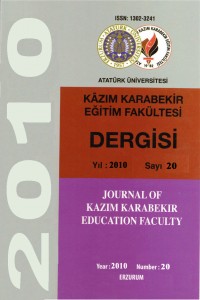KURT MARTIN’NİN ‚NEAPEL SEHEN’ ADLI ÖYKÜSÜ İLE M. ŞEVKE ESENDAL’IN ‚HASTA’ ADLI ÖYKÜSÜNDE SANRILI İNSAN İMGESİ/ The image of hallucinating person in short stories ‘Neapel Sehen’ of Kurt Marti and ‘Hasta’ of M. Şefket Esendal.
Abstract
20. yüzyılın sanatsal yapılara yüklediği çokgenli anlam, yeni bir söylem biçimiyle kendi dünyasını
yaratmıştır. Buna modern sonrası gerçeklik, postmodern yaklaşım, yazının kendini kurgulaması yada
ne dersek diyelim, yazın sanatında derin (öz) gerçekliğin varlığı önemli ölçüde varlığını
duyurmaktadır. Bu bağlamda imgenin, bir sanatsal yaratıda anlam yaratma, yazıya anlamsal derinlik
kazandırma, anlatıda dil olgusunun kendine dönük olarak işlevselliğini ortaya koyması gibi görevler
üstlendiği bilinmektedir.
20. yüzyılın bu estetik konseptinde yerini alan bu yeni kurgulama sanatı (üst kurmaca) yeni ve
farklı bir okuma tarzını da zorunlu kılmış bulunmaktadır. Bu noktadan yola çıkarak, Kurt Marti ve
M. Ş. Esendal’ın adı geçen öykülerinde çağın, teknolojik verileri karşısında varlığının
sorunlaştığı sanrılı insanın, somatik ve nörotik dışa vurumlarının patolojisini bir imge olarak
tartıştım. ‚Ben’ ve ‚öteki’ bağlamında, özgün ve yabancı kültür değerleri dizgesinde aynı çağdaş
sorunlar kuşağında, çağın insanını varlık sorununa sürükleyen anomalilerin psikososyal coğrafyasını
irdelemeye çalıştım. Çalışmamda kullandığım metodik yaklaşımlar, Alımlama estetiği ve psikanaliz
yaklaşımlardan oluşmaktadır.
Anahtar Sözcükler: Psikanaliz, öz gerçeklik, sanrılı insan, postmodern
söylem.
Multi faceted meaning assigned to Works of art by the 20th century has
created its own world with a new form of discourse. Whether we call it the postmodern reality,
postmodern approach, or the fictionalising of the literature, the existance of the deep (essential)
reality expresses itself significantly. In this context, the image undertook functions like
creation of meaning, deepening of meaning, expression in a narrative of the language as a fact to
itself.
The new art of fictionalising (surfiction) in the aesthetic concept of the 20th century has
required a new and different stly of reading. Consequently, I tried to explicate as an image the
pathology of somatic and neuratic expressions of the hallucinating person whose existance has
become problematic in the face of the technology of the present age in the aforementioned stories
by Kurt Marti and M.Ş. Esendal. The methods used in my study are aesthtic perception and
psychoanalysis.
Keywords: psychoanalysis, a fact to itself, hallucinating person, postmodern discourse.
Keywords
There are 0 citations in total.
Details
| Primary Language | tr;en |
|---|---|
| Journal Section | Makaleler |
| Authors | |
| Publication Date | January 27, 2013 |
| Submission Date | January 27, 2013 |
| Published in Issue | Year 2010 Issue: 20 |


